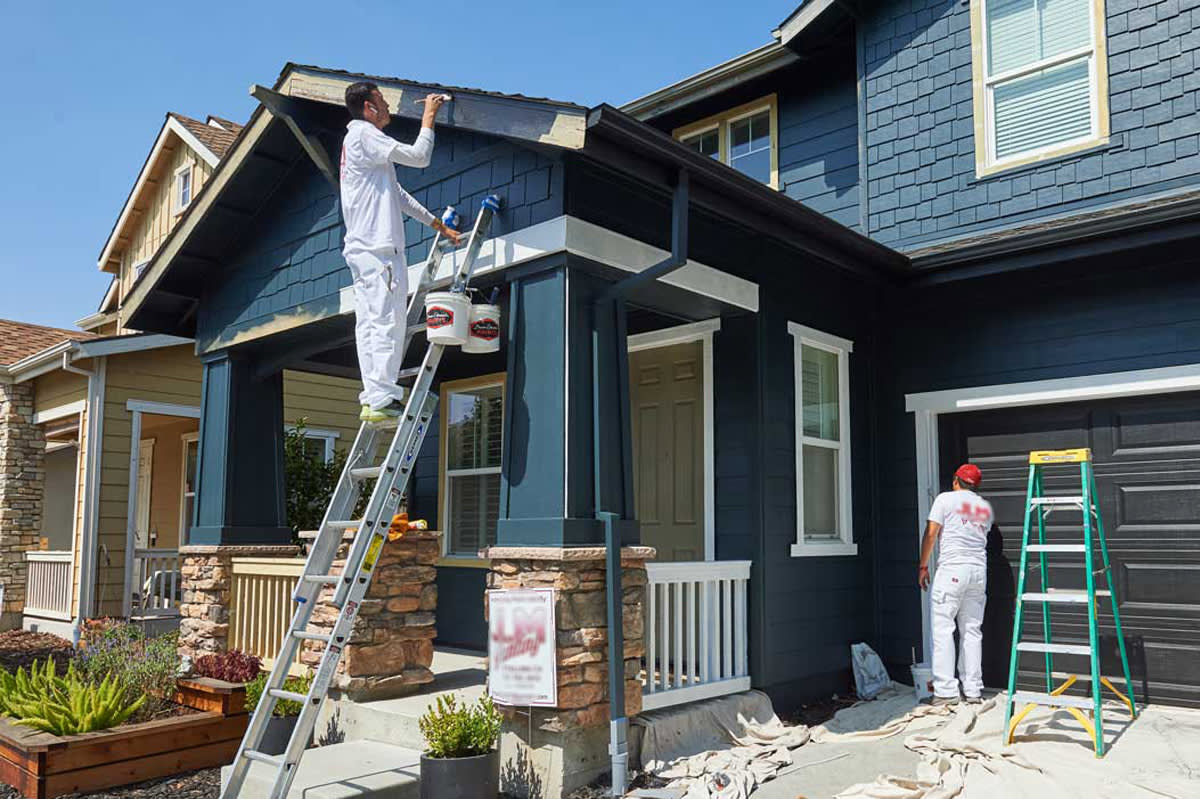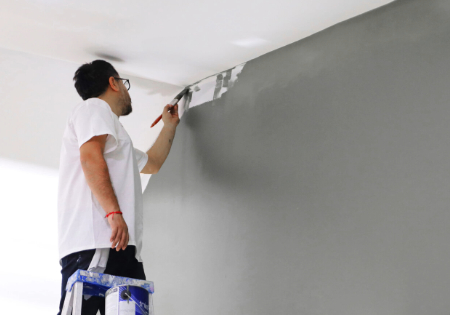Learn the best way to Choose premium Paints at a local paint store corpus christi tx
Checking Out the Various Sorts Of Paint: A Guide for each Task
Discovering the various kinds of paint is crucial for attaining the desired end result in any kind of task. From water-based choices that provide convenience to oil-based paints recognized for their sturdiness, each choice has its merits. Specialty paints can add unique appearances or finishes, while eco-friendly options accommodate those seeking sustainability. Understanding these differences can greatly influence the success of a paint endeavor. What aspects should one take into consideration when making the appropriate option?
Comprehending Paint Kinds: Oil-Based vs. water-based
Paint types can significantly influence a project's outcome, and comprehending the differences between water-based and oil-based paints is essential for informed decision-making. Water-based paints, commonly referred to as latex paints, are made up of water as the primary solvent. They dry quickly, discharge less unpredictable natural compounds (VOCs), and are very easy to clean up with soap and water. This makes them a popular selection for indoor applications and settings where air quality is a concern.
On the other hand, oil-based paints utilize organic solvents, offering a sturdy, shiny surface perfect for surfaces subjected to put on and tear, such as trim and cabinets. They take longer to dry, need mineral spirits for cleaning, and have a more powerful smell. benjamin moore paint store corpus christi. Selecting in between these two kinds relies on the details needs of the task, considering variables such as wanted surface, application setting, and ease of upkeep. Each type has distinct benefits and restrictions, guiding the option procedure
The Finish Issues: Selecting In Between Matte, Satin, and Gloss
When selecting a paint surface, the selection in between matte and glossy options significantly affects both looks and performance. Matte surfaces supply a refined, non-reflective appearance that can conceal surface area blemishes, while glossy surfaces offer longevity and ease of cleaning. Recognizing the advantages and considerations of each can aid in making an educated decision for any type of paint project.
Matte End Up Advantages
Numerous property owners debate the merits of numerous finishes, matte paint offers distinctive benefits that make it a preferred selection for both indoor and exterior applications. One of the main benefits of matte surface is its capability to conceal surface blemishes, producing a smoother appearance on wall surfaces. This quality is especially beneficial in older homes or spaces with unequal surface areas. Additionally, matte paint takes in light as opposed to showing it, which can boost the aesthetic of a room by giving a more advanced and soft appearance. Matte coatings are commonly less complicated to touch up than glossier options, as they can blend extra seamlessly when applied over existing paint. Overall, matte paint is an exceptional choice for those seeking a fine-tuned and sophisticated coating.
Glossy End Up Factors To Consider
A shiny coating can significantly alter the perception of a space, supplying a streamlined and reflective top quality that improves both color vibrancy and light within a room. This coating is often preferred for high-traffic areas and surfaces like bathroom and kitchens, where sturdiness and convenience of cleansing are necessary. Its reflective nature can highlight imperfections on walls, making proper surface preparation essential. Shiny paints additionally often tend to show spots and fingerprints quicker, demanding normal upkeep. Furthermore, lighting plays a significant function; in intense atmospheres, a shiny finish may create glare, influencing the total aesthetic. Cautious factor to consider of the certain application and environment is vital when selecting a glossy surface for any task.
Specialty Paints: When to Make Use Of Distinctive or Chalk Paint
Specialized paints, such as distinctive and chalk paint, deal special visual and functional advantages that can enhance numerous surface areas. Textured paint is optimal for producing depth and dimension on walls, hiding imperfections while adding a three-dimensional feel. It is specifically beneficial in high-traffic locations where longevity and aesthetic interest are essential.

Both kinds of specialized paints can transform spaces, however choosing the ideal one depends upon the desired effect and surface needs. Distinctive paint might match bigger areas, while chalk paint can revitalize smaller things, showcasing creativity and individual design in any type of job.
Outdoor Paints: Safeguarding Your Surfaces From the Components
Exterior paints are essential for protecting surfaces versus various climate condition. Recognizing their climate resistance features, correct surface area prep work requirements, and efficient application methods can greatly boost durability and efficiency. This area will certainly lay out key considerations for picking and making use of exterior paints successfully.
Climate Resistance Includes
Weather condition resistance is a necessary function of outside paints, as it establishes how well surfaces can stand up to the rough elements of nature. High-quality outside paints are developed to stand up to damages from UV rays, wetness, and temperature fluctuations. UV resistance warranties colors continue to be lively with time, preventing fading and discoloration. Moisture resistance safeguards versus mold and mildew and mildew, which can endanger the stability of surface areas. In addition, paints with exceptional temperature resistance can contract and broaden without cracking, keeping their protective top qualities. When choosing exterior paints, it is crucial to take into consideration these climate resistance attributes, as they add to the longevity and longevity of painted surface areas, ensuring they continue to be aesthetically pleasing and useful in spite of exposure to the aspects.
Surface Area Preparation Requirements
Appropriate surface preparation is a basic step in accomplishing the most effective results with exterior paints. To guarantee suitable adhesion and toughness, surface areas should be thoroughly cleansed, removing dirt, mold, and oil. This can be completed utilizing a pressure washing machine or a scrub brush with an appropriate cleansing remedy. Once cleaned up, surfaces must be inspected for any peeling or flaking paint, which have to be scratched away to produce a smooth structure. Fixing any type of holes or cracks is also vital, as these can permit dampness seepage. In addition, fining sand rough areas promotes better paint adhesion. Ultimately, using a primer matched for exterior use can boost the paint's performance, ensuring a durable coating that endures the components. Proper preparation is crucial to a successful outside paint job.
Application Strategies Tips
While applying exterior paints, it is important to utilize efficient methods that assure surfaces are well-protected versus the elements. Pick the ideal day for painting; reduced moisture and mild temperatures boost bond and drying out. Prepping the surface area extensively-- cleansing, sanding, and priming-- makes sure far better paint bond and sturdiness. Utilizing premium brushes or rollers can give a smoother surface, while spray painting might cover huge areas effectively. Applying paint in slim, even layers avoids runs and drips. It is advisable to comply with producer directions pertaining to drying out times between layers. Confirm proper air flow throughout application to facilitate drying and reduce exposure to fumes. These methods considerably improve the longevity and effectiveness of outside paint.
Eco-Friendly Options: Low-VOC and Zero-VOC Paints
As customers come to be progressively familiar with the environmental effect of their choices, low-VOC and zero-VOC paints have emerged as prominent alternatives. These paints are created to consist of fewer unstable natural substances (VOCs), which are chemicals that can vaporize into the air and add to air pollution and health and wellness issues. Low-VOC paints generally contain a restricted quantity of VOCs, while zero-VOC paints have minimal levels, making them more secure for both outdoor and indoor usage.
The benefits of using zero-voc and low-voc paints extend past ecological considerations; they likewise enhance indoor air high quality, reducing the threat of breathing issues and allergies. Numerous producers now supply a variety of colors and coatings in environmentally friendly options, making it easier for consumers to discover suitable products for their jobs. By opting for these paints, people can add to a much healthier atmosphere while still accomplishing the visual they want in their spaces.
Tools and Strategies for a Remarkable Application
Achieving a remarkable paint application requires the right tools and techniques, which can considerably improve the last result. Selecting the appropriate brush or roller is vital; brushes function well for edges and complex locations, while rollers cover bigger surface areas effectively. Making use of top notch materials guarantees far better paint circulation and decreases streaks. For suitable results, surface prep work is essential. This consists of cleaning, fining sand, and priming surfaces to promote bond.
Method also plays a considerable function. The "W" technique with a roller aids to uniformly distribute paint, while long, smooth strokes with a brush prevent visible lines. Working in sections permits better control and blending. Furthermore, using slim coats is preferable to thick layers, minimizing the threat of drips and irregular structures. Ultimately, keeping a wet edge during application helps attain smooth changes in between locations. By combining these tools and techniques, one can attain a polished and specialist surface.
Tips for Maintaining and Caring for Your Painted Surfaces
Correct maintenance and care of colored surfaces can considerably expand their life-span and maintain their look. Normal cleansing is essential; utilizing a soft fabric or sponge with moderate soap and water can get rid of dust and dust without damaging the paint. It is a good idea to prevent unpleasant cleansers or scrubbing pads, as these can scratch the surface area. Additionally, applying a fresh layer of paint every few years can revitalize the shade and protect against wear.
For outdoor surfaces, inspecting for signs of peeling or fading frequently is very important. Quickly addressing any kind of issues prevents additional damage. In locations prone to wetness, such as restrooms, using mold-resistant paint and making certain appropriate ventilation can help keep the stability of the paint. Utilizing safety surfaces can secure versus UV rays and spots, guaranteeing that painted surface areas stay appealing and vivid for years to come, inevitably improving the total aesthetic of the space.
Visual Regularly Asked Questions
Can I Mix Different Kind Of Paint With Each Other?
Mixing various kinds of paint is typically not recommended, as it can bring about issues like poor adhesion, inconsistent appearance, or unanticipated chemical reactions. It's ideal to use compatible paints for suitable results and longevity.

Just how Do I Correctly Shop Surplus Paint?
To properly store leftover paint, seal the container tightly, tag it with the date and shade, and keep it in an amazing, completely dry location far from straight sunlight and extreme temperature levels for ideal conservation.
What Is the most effective Way to Take Care Of Extra Paint?
The ideal method to throw away extra paint is to examine neighborhood regulations, as many locations have actually marked hazardous waste facilities. Conversely, consider donating functional paint to neighborhood companies or schools for their tasks.
Just How Can I Tell if Paint Is Still Great to Make Use Of?
To figure out if paint is still great, examine its consistency, odor, and color. If it appears apart, has an unpleasant odor, or reveals significant adjustments in appearance, it's likely no more useful.
Exist Age Restrictions for Buying Paint Products?
In numerous regions, there are no details age restrictions for buying paint items. However, some stores may call for clients to be at least 18 years of ages, particularly for products having solvents or unsafe products.
Paint kinds can considerably impact a task's result, and recognizing the differences between oil-based and water-based paints is necessary for educated decision-making. Water-based paints, often referred to as latex paints, are made up of water as the primary solvent. In contrast, oil-based paints make use of organic solvents, supplying website a long lasting, shiny finish ideal for surfaces revealed to tear and put on, such as trim and cabinets. Specialty paints, such as distinctive and chalk paint, offer distinct aesthetic and sensible advantages that can enhance various surface areas. In locations prone to moisture, such as bathrooms, making use of mold-resistant paint and ensuring appropriate ventilation can help maintain the integrity of the paint.